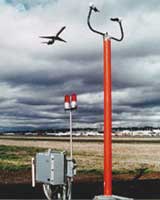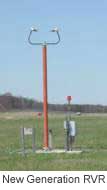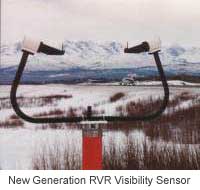Navigation Services
Lighting Systems Group - RVR
RVR is a critical component in determining what the ILS minimums will be for each landing Category. The lowest authorized ILS minimums, with all required ground and airborne systems components operative, are: (a) Category I Decision Height (DH) 200 feet and Runway Visual Range (RVR) 2,400 feet (with touchdown zone and centerline lighting, RVR 1,800 feet); (b) Category II DH 100 feet and RVR 1,200 feet; (c) Category IIIa No DH or DH below 100 feet and RVR not less than 700 feet; (d) Category IIIb No DH or DH below 50 feet and RVR less than 700 feet but not less than 150 feet; (e) Category IIIc No DH and no RVR limitation. Also, the RVR visibility readings assist Airport Traffic Control Tower (ATCT) controllers when issuing control instructions to avoid interfering operations within ILS critical areas at controlled airports. FAA Navigation Services Technical Lead: Current Status: There are approximately 271 RVR systems in the NAS, of which 212 are forward scatter NG RVR Systems and 54 are older Transmissometer Systems. A new PC-Based RVR contract was awarded and first article systems were delivered for testing March 2007. Applicable Documents: |

 The RVR (Runway Visual Range) is required to support precision landing and takeoff operations in the NAS. The system measures visibility, background luminance, and runway light intensity to determine the distance a pilot should be able to see down the runway. RVRs are needed to support increased landing capacity at existing airports, and as Instrument Landing System (ILS) installations are qualified per the requirements of the Airway Planning Standard (APS-1) and with the Operational Evolution Plan (OEP), supports new airport construction. Each RVR system consists of the following functional elements: Visibility Sensor, Ambient Light Sensor, Runway Light Intensity Monitor, Data Processing Unit and Controller Display(s). The RVR interfaces with the Automated Surface Observing System (ASOS), Enhanced Traffic Management System (ETMS), and Maintenance Processing System (MPS). These interfaces enhance safety, increase system capacity,
and improve maintenance within the NAS.
The RVR (Runway Visual Range) is required to support precision landing and takeoff operations in the NAS. The system measures visibility, background luminance, and runway light intensity to determine the distance a pilot should be able to see down the runway. RVRs are needed to support increased landing capacity at existing airports, and as Instrument Landing System (ILS) installations are qualified per the requirements of the Airway Planning Standard (APS-1) and with the Operational Evolution Plan (OEP), supports new airport construction. Each RVR system consists of the following functional elements: Visibility Sensor, Ambient Light Sensor, Runway Light Intensity Monitor, Data Processing Unit and Controller Display(s). The RVR interfaces with the Automated Surface Observing System (ASOS), Enhanced Traffic Management System (ETMS), and Maintenance Processing System (MPS). These interfaces enhance safety, increase system capacity,
and improve maintenance within the NAS.
